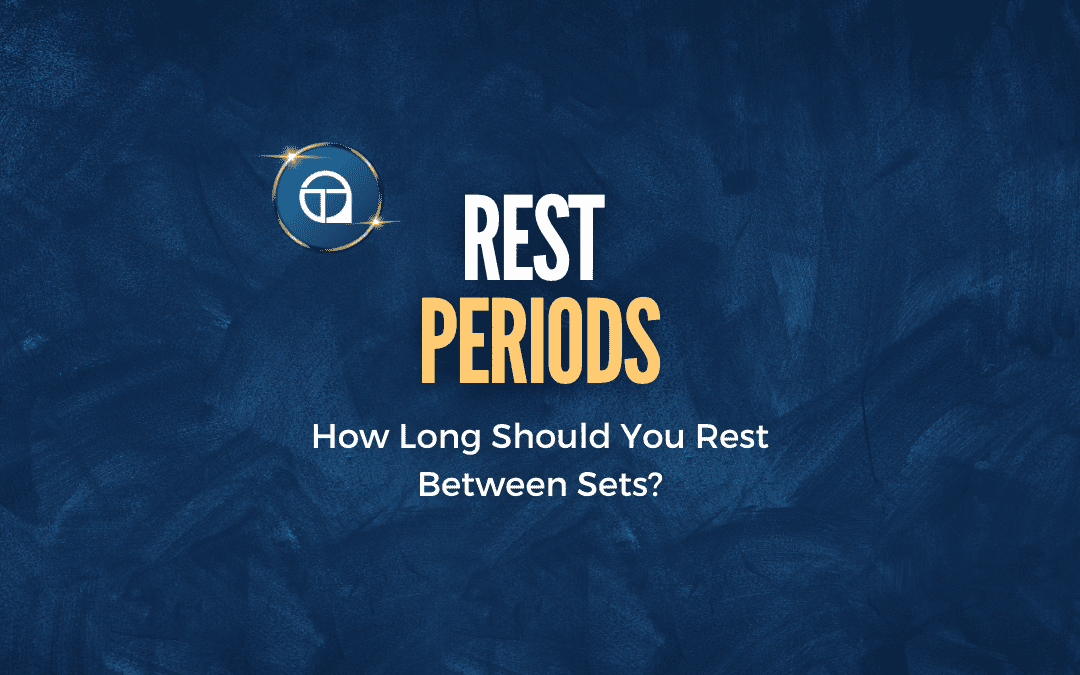This isn’t a hugely controversial or in-depth topic, however, to really dig into it, I am going to need to assume that you have already read our article on understanding reps, as this does cover a lot of stuff around reps that will allow you to better understand and utilise the information in this article. Our articles on RIR and RPE and tempo are also quite helpful in rounding out your knowledge of reps, and thus will allow you to better understand volume and thus how long you should be resting between your sets.
If you haven’t already, it would be incredibly helpful to also read our articles on why exercise is important, the goals of exercise, the types of exercise we have available to us, and to have a rough idea of the general exercise guidelines. It would also be helpful if you had a good understanding of why and how we use resistance training to build muscle and strength. I am also going to assume that if you intend to use this information to make better exercise programs, you have already spent some time thinking about your exercise selection and have ensured it is appropriate for your goals.
You can also visit our exercise hub for more content on exercise.
Before we get stuck in, I would just like to remind you that we offer comprehensive online coaching. So if you need help with your own exercise program or nutrition, don’t hesitate to reach out. If you are a coach (or aspiring coach) and want to learn how to coach nutrition, then consider signing up to our Nutrition Coach Certification course. We do also have an exercise program design course in the works, if you are a coach who wants to learn more about effective program design and how to coach it. We do have other courses available too.
Now, with all that out of the way, we can actually get stuck into the discussion of rest periods!
Table of Contents
Rest Periods
But I am getting ahead of myself.
Why do we need to rest between sets in the first place?
Why Do You Need Rest Periods
This is a basic question, that surprisingly doesn’t get answered a lot. Most people just accept that they need rest periods, because they feel a bit tired after doing a set. So it is pretty intuitive that rest periods are needed. However, because the discussion is really only at this surface level understanding, people end up not fully taking advantage of rest periods.
So, understanding why you need rest periods is actually quite helpful to your understanding overall. And it isn’t even that complicated.
The first reason you need rest periods is that your muscles have just worked intensely during your last set, and they need to recover to some extent. Now, you are unlikely to see full recovery in a short rest period, as the body simply can’t fully heal up from any muscle damage that has occurred during that set.
So the recovery is less about repairing any muscle protein structures and more about recovering energetically. Muscle contractions during exercise use up adenosine triphosphate (ATP), the primary energy source for muscle activity. This ATP is generally “created” from either stored creatine phosphate or glucose/glycogen. Rest periods give your body time to replenish ATP and other energy stores like creatine phosphate, allowing you to maintain performance in subsequent sets.
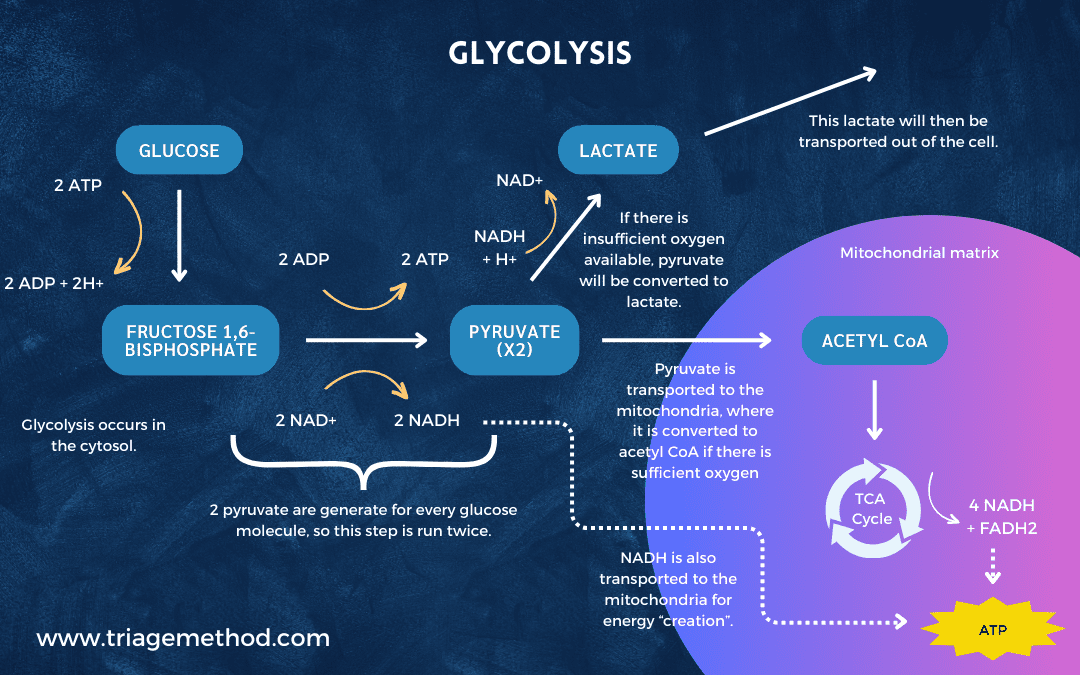
It is the aerobic system that is restocking these stores, although muscle contraction in the context of resistance training is generally a more glycolytic activity. As a result of muscle contraction being more glycolytic, there is generally a build up of metabolites such as lactate and hydrogen. The hydrogen is what causes that burning sensation in your muscles.
Which brings us to the second reason you need rest periods. During rest periods, these metabolic byproducts are cleared from the muscles. The lactate either gets converted to pyruvate in the presence of oxygen and is then useable in the TCA cycle to create energy, or the lactate is shuttled to the liver to be converted to pyruvate via the Cori cycle. The increased hydrogen is also cleared during the rest periods, and as you have probably experienced, the burning sensation goes away quickly enough.
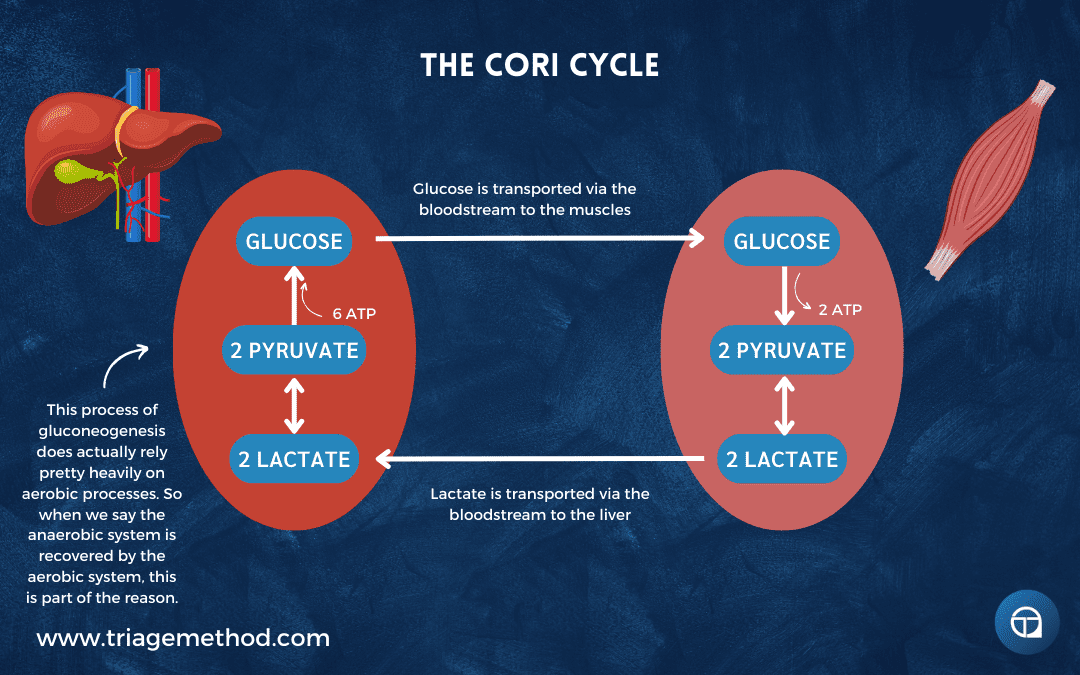
Metabolite clearance doesn’t just happen quickly, and it does tend to take a surprisingly long time to see full clearance of the metabolites (i.e. 30+ minutes depending on the exact metabolite of interest). So you simply aren’t see complete clearance of metabolites in a short rest period between sets.
However, we do see a significant reduction in fairly short time frames. Something like 2-5 minutes of rest will see significant reductions in metabolite levels. Shorter rest periods tend to not allow for significant clearance, but this obviously depends on the amount of metabolic byproducts generated along with genetics, fitness levels and a whole host of other factors.
With incomplete metabolite clearance, fatigue does tend to be higher in subsequent sets and thus performance tends to be lower.
Now, it is not just the muscular system that needs to recover between sets. The nervous system that controls the muscles also needs to recover. This is the third reason we need to have rest periods, to allow the nervous system to recover.
Neurotransmitters, such as acetylcholine, which are crucial to muscle contraction are resynthesised and replenished during rest periods. Enzymes break down used neurotransmitters, and their components are recycled for future use. Synaptic vesicles, which store neurotransmitters, are reformed and refilled at the synaptic terminals.
Ion balance also needs to be restored to allow for muscle contraction. After nerve impulses (action potentials), neurons need to restore their resting membrane potential. This is achieved by actively pumping sodium (Na⁺) ions out of the cell and potassium (K⁺) ions into the cell using the sodium-potassium pump (Na⁺/K⁺-ATPase). Excess calcium ions (Ca²⁺) that entered the neuron during neurotransmitter release are actively transported out of the cell or sequestered into internal stores.
This all needs to occur to allow subsequent sets to be high quality. Nervous system recovery does tend to take a little bit longer than muscular recovery, and anybody who has done very heavy reps can attest to this. The body can feel ready to go relatively quickly, but the nervous system just takes a bit longer. This is difficult to describe, but if you have felt it, you know exactly what I mean.
Finally, rest periods are also required to regain mental focus. While people often forget this, lifting weights is actually quite a skill. You have to coordinate a lot of movement, both to lift the weights and to stabilise your body and joints. You can’t be daydreaming while lifting heavy weights, and as a result, there is a certain amount of mental fatigue generated. Rest periods provide a mental break, which helps you to maintain focus and concentration during your subsequent sets.
Ultimately, you need to rest to allow subsequent sets to be the highest quality they can be. Shorter rest periods, generally means fewer effective reps across a workout. However, excessively long rest periods increase the likelihood of your cooling down and getting out of the rhythm of the exercise.
So, how long should your rest periods be?
How Long Should Your Rest Periods Be?
This is a complicated question to answer, as people have different goals with their training programs. However, if we take it that we want to build muscle and/or strength, then we probably want to get close to “full recovery” between sets. This allows us to maximise the total amount of effective reps we can accumulate across a workout.
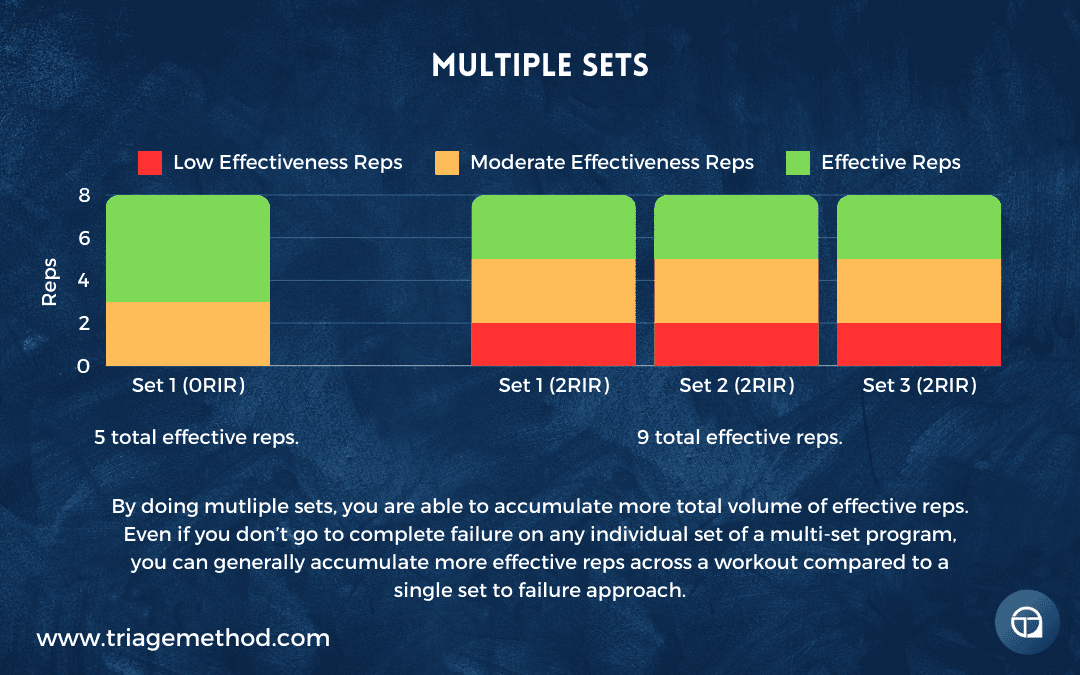
Merely doing multiple sets isn’t going to lead to more results, if that extra volume is just junk volume. It needs to be high quality volume, and resting sufficiently between sets allows you to ensure that subsequent sets are high quality.
Full recovery of the muscles and nervous system likely doesn’t occur for 48-72 hours, however, for the purposes of being able to perform at a high level in subsequent sets, we likely only need 2-5 minutes to see “full recovery”.
- Longer rest periods (2-5 minutes) between sets are recommended to allow both the muscular and nervous systems to recover adequately.
- Moderate rest periods (60-90 seconds) are often used, although there may be incomplete recovery as a result.
- Short rest periods (<60 seconds) generally don’t allow for a high degree of recovery between sets, and performance on subsequent sets will almost certainly be compromised.
There may be some differences in recovery between exercises, and generally, exercises that use more muscle mass or require more joints to move, require longer periods of time to recover. While isolation exercises for small muscle groups may actually recover quite quickly.
So, don’t take the 2-5 minute guideline for “full recovery” to be gospel. It is just a rough guideline.
You must also factor in that sometimes incomplete recovery is the goal. For protocols that are trying to target the metabolic stress vector of muscle growth, short rest periods with incomplete clearance of metabolites may be the goal. Similarly, some athletes trying to build localised muscular tolerance to acidosis may use incomplete recovery.
Different rest periods are better for different jobs, and there is no perfect, generalisable rest period (although if you have specific goals, we can give a specific rest period recommendation).
Ultimately, the exact rest period that makes the most sense, depends on the specific goal. However, it is important to at least standardise your rest periods across all your sets of an exercise and from workout to workout. You can’t compare workouts and accurately track progress if one week you took 3-minute rest periods and then the next week you took 1-minute rest periods. To accurately compare and track progress, there must be some standardisation. Don’t just chop and change them from workout to workout.
Rest Periods In Practice
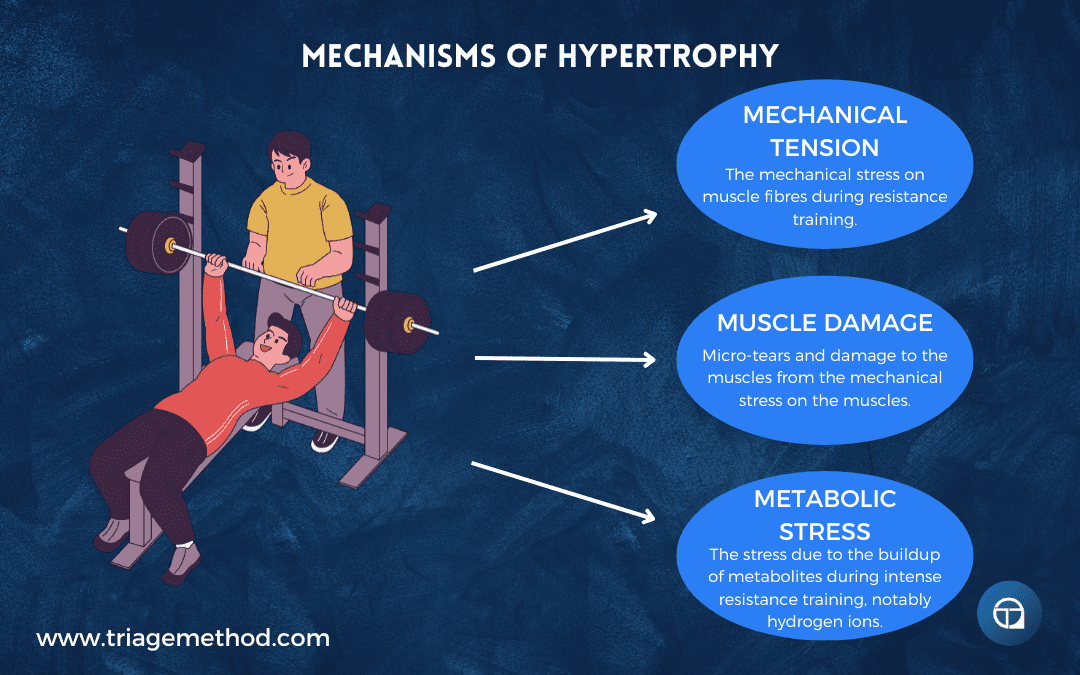
If you feel like you haven’t recovered enough between sets, you can simply rest for longer (unless the goal is incomplete recovery). However, if you do rest for longer, this should be noted and it should be used to inform your future progressions. You don’t want to fall into the trap of “progressing” by slowly taking longer between your sets. You want to keep your rest periods somewhat consistent.
Rest Periods Conclusion
Rest periods aren’t that difficult to understand, however, many people still make some fundamental mistakes with their use of rest periods. In general, we want to try and prioritise (near) complete recovery between sets, as this allows us to maximise the number of effective reps that we can perform across a workout. However, sometimes incomplete rest can make sense.
As a result, we generally recommend that for most people, a 2-3 minute rest period is best practice. Shorter or longer rest periods can be used, but the default should be 2-3 minutes.
As with everything, there is always more to learn, and we haven’t even begun to scratch the surface with all this stuff. However, if you are interested in staying up to date with all our content, we recommend subscribing to our newsletter and bookmarking our free content page. We do have a lot of content on how to design your own exercise program on our exercise hub.
If you would like more help with your training (or nutrition), we do also have online coaching spaces available.
We also recommend reading our foundational nutrition article, along with our foundational articles on sleep and stress management, if you really want to learn more about how to optimise your lifestyle. If you want even more free information on exercise, you can follow us on Instagram, YouTube or listen to the podcast, where we discuss all the little intricacies of exercise.
Finally, if you want to learn how to coach nutrition, then consider our Nutrition Coach Certification course. We do also have an exercise program design course in the works, if you are a coach who wants to learn more about effective program design and how to coach it. We do have other courses available too. If you don’t understand something, or you just need clarification, you can always reach out to us on Instagram or via email.
The previous article in this series is about Training Volume and the next article in this series is a Review of Resistance Training Guidelines, if you are interested in continuing to learn about exercise program design. You can also go to our exercise hub to find more exercise content.
References and Further Reading
Furrer R, Hawley JA, Handschin C. The molecular athlete: exercise physiology from mechanisms to medals. Physiol Rev. 2023;103(3):1693-1787. doi:10.1152/physrev.00017.2022 https://www.ncbi.nlm.nih.gov/pmc/articles/PMC10110736/
Noto RE, Leavitt L, Edens MA. Physiology, Muscle. In: StatPearls. Treasure Island (FL): StatPearls Publishing; May 1, 2023. https://pubmed.ncbi.nlm.nih.gov/30335291/
Stone MH, Hornsby WG, Suarez DG, Duca M, Pierce KC. Training Specificity for Athletes: Emphasis on Strength-Power Training: A Narrative Review. J Funct Morphol Kinesiol. 2022;7(4):102. Published 2022 Nov 16. doi:10.3390/jfmk7040102 https://www.ncbi.nlm.nih.gov/pmc/articles/PMC9680266/
Suchomel TJ, Nimphius S, Bellon CR, Stone MH. The Importance of Muscular Strength: Training Considerations. Sports Med. 2018;48(4):765-785. doi:10.1007/s40279-018-0862-z https://pubmed.ncbi.nlm.nih.gov/29372481/
Reggiani C, Schiaffino S. Muscle hypertrophy and muscle strength: dependent or independent variables? A provocative review. Eur J Transl Myol. 2020;30(3):9311. Published 2020 Sep 9. doi:10.4081/ejtm.2020.9311 https://www.ncbi.nlm.nih.gov/pmc/articles/PMC7582410/
Wilson JM, Loenneke JP, Jo E, Wilson GJ, Zourdos MC, Kim JS. The effects of endurance, strength, and power training on muscle fiber type shifting. J Strength Cond Res. 2012;26(6):1724-1729. doi:10.1519/JSC.0b013e318234eb6f https://pubmed.ncbi.nlm.nih.gov/21912291/
Buckner SL, Jessee MB, Mouser JG, et al. The Basics of Training for Muscle Size and Strength: A Brief Review on the Theory. Med Sci Sports Exerc. 2020;52(3):645-653. doi:10.1249/MSS.0000000000002171 https://pubmed.ncbi.nlm.nih.gov/31652235/
Krzysztofik M, Wilk M, Wojdała G, Gołaś A. Maximizing Muscle Hypertrophy: A Systematic Review of Advanced Resistance Training Techniques and Methods. Int J Environ Res Public Health. 2019;16(24):4897. Published 2019 Dec 4. doi:10.3390/ijerph16244897 https://www.ncbi.nlm.nih.gov/pmc/articles/PMC6950543/
Schoenfeld BJ, Grgic J, Van Every DW, Plotkin DL. Loading Recommendations for Muscle Strength, Hypertrophy, and Local Endurance: A Re-Examination of the Repetition Continuum. Sports (Basel). 2021;9(2):32. Published 2021 Feb 22. doi:10.3390/sports9020032 https://www.ncbi.nlm.nih.gov/pmc/articles/PMC7927075/
Ralston GW, Kilgore L, Wyatt FB, Buchan D, Baker JS. Weekly Training Frequency Effects on Strength Gain: A Meta-Analysis. Sports Med Open. 2018;4(1):36. Published 2018 Aug 3. doi:10.1186/s40798-018-0149-9 https://pubmed.ncbi.nlm.nih.gov/30076500/
Behm DG, Young JD, Whitten JHD, et al. Effectiveness of Traditional Strength vs. Power Training on Muscle Strength, Power and Speed with Youth: A Systematic Review and Meta-Analysis. Front Physiol. 2017;8:423. Published 2017 Jun 30. doi:10.3389/fphys.2017.00423 https://www.ncbi.nlm.nih.gov/pmc/articles/PMC5491841/
Maestroni L, Read P, Bishop C, et al. The Benefits of Strength Training on Musculoskeletal System Health: Practical Applications for Interdisciplinary Care. Sports Med. 2020;50(8):1431-1450. doi:10.1007/s40279-020-01309-5 https://pubmed.ncbi.nlm.nih.gov/32564299/
Folland JP, Williams AG. The adaptations to strength training : morphological and neurological contributions to increased strength. Sports Med. 2007;37(2):145-168. doi:10.2165/00007256-200737020-00004 https://pubmed.ncbi.nlm.nih.gov/17241104/
Iversen VM, Norum M, Schoenfeld BJ, Fimland MS. No Time to Lift? Designing Time-Efficient Training Programs for Strength and Hypertrophy: A Narrative Review. Sports Med. 2021;51(10):2079-2095. doi:10.1007/s40279-021-01490-1 https://www.ncbi.nlm.nih.gov/pmc/articles/PMC8449772/
Calatayud J, Vinstrup J, Jakobsen MD, et al. Importance of mind-muscle connection during progressive resistance training. Eur J Appl Physiol. 2016;116(3):527-533. doi:10.1007/s00421-015-3305-7 https://pubmed.ncbi.nlm.nih.gov/26700744/
Colquhoun RJ, Gai CM, Aguilar D, et al. Training Volume, Not Frequency, Indicative of Maximal Strength Adaptations to Resistance Training. J Strength Cond Res. 2018;32(5):1207-1213. doi:10.1519/JSC.0000000000002414 https://pubmed.ncbi.nlm.nih.gov/29324578/
Thomas MH, Burns SP. Increasing Lean Mass and Strength: A Comparison of High Frequency Strength Training to Lower Frequency Strength Training. Int J Exerc Sci. 2016;9(2):159-167. Published 2016 Apr 1. https://www.ncbi.nlm.nih.gov/pmc/articles/PMC4836564/
Schumann M, Feuerbacher JF, Sünkeler M, et al. Compatibility of Concurrent Aerobic and Strength Training for Skeletal Muscle Size and Function: An Updated Systematic Review and Meta-Analysis. Sports Med. 2022;52(3):601-612. doi:10.1007/s40279-021-01587-7 https://pubmed.ncbi.nlm.nih.gov/34757594/
de Santana DA, Castro A, Cavaglieri CR. Strength Training Volume to Increase Muscle Mass Responsiveness in Older Individuals: Weekly Sets Based Approach. Front Physiol. 2021;12:759677. Published 2021 Sep 30. doi:10.3389/fphys.2021.759677 https://www.ncbi.nlm.nih.gov/pmc/articles/PMC8514686/
Balshaw TG, Maden-Wilkinson TM, Massey GJ, Folland JP. The Human Muscle Size and Strength Relationship: Effects of Architecture, Muscle Force, and Measurement Location. Med Sci Sports Exerc. 2021;53(10):2140-2151. doi:10.1249/MSS.0000000000002691 https://pubmed.ncbi.nlm.nih.gov/33935234/
Bernárdez-Vázquez R, Raya-González J, Castillo D, Beato M. Resistance Training Variables for Optimization of Muscle Hypertrophy: An Umbrella Review. Front Sports Act Living. 2022;4:949021. Published 2022 Jul 4. doi:10.3389/fspor.2022.949021 https://www.ncbi.nlm.nih.gov/pmc/articles/PMC9302196/
Heidel KA, Novak ZJ, Dankel SJ. Machines and free weight exercises: a systematic review and meta-analysis comparing changes in muscle size, strength, and power. J Sports Med Phys Fitness. 2022;62(8):1061-1070. doi:10.23736/S0022-4707.21.12929-9 https://pubmed.ncbi.nlm.nih.gov/34609100/
Ralston GW, Kilgore L, Wyatt FB, Baker JS. The Effect of Weekly Set Volume on Strength Gain: A Meta-Analysis. Sports Med. 2017;47(12):2585-2601. doi:10.1007/s40279-017-0762-7 https://pubmed.ncbi.nlm.nih.gov/28755103/
Suchomel TJ, Nimphius S, Bellon CR, Hornsby WG, Stone MH. Training for Muscular Strength: Methods for Monitoring and Adjusting Training Intensity. Sports Med. 2021;51(10):2051-2066. doi:10.1007/s40279-021-01488-9 https://pubmed.ncbi.nlm.nih.gov/34101157/
Androulakis-Korakakis P, Michalopoulos N, Fisher JP, et al. The Minimum Effective Training Dose Required for 1RM Strength in Powerlifters. Front Sports Act Living. 2021;3:713655. Published 2021 Aug 30. doi:10.3389/fspor.2021.713655 https://pubmed.ncbi.nlm.nih.gov/34527944/
Helms ER, Kwan K, Sousa CA, Cronin JB, Storey AG, Zourdos MC. Methods for Regulating and Monitoring Resistance Training. J Hum Kinet. 2020;74:23-42. Published 2020 Aug 31. doi:10.2478/hukin-2020-0011 https://pubmed.ncbi.nlm.nih.gov/33312273/
Ruple BA, Plotkin DL, Smith MA, et al. The effects of resistance training to near failure on strength, hypertrophy, and motor unit adaptations in previously trained adults. Physiol Rep. 2023;11(9):e15679. doi:10.14814/phy2.15679 https://pubmed.ncbi.nlm.nih.gov/37144554/
Zourdos MC, Klemp A, Dolan C, et al. Novel Resistance Training-Specific Rating of Perceived Exertion Scale Measuring Repetitions in Reserve. J Strength Cond Res. 2016;30(1):267-275. doi:10.1519/JSC.0000000000001049 https://pubmed.ncbi.nlm.nih.gov/26049792/
Mangine GT, Serafini PR, Stratton MT, Olmos AA, VanDusseldorp TA, Feito Y. Effect of the Repetitions-In-Reserve Resistance Training Strategy on Bench Press Performance, Perceived Effort, and Recovery in Trained Men. J Strength Cond Res. 2022;36(1):1-9. doi:10.1519/JSC.0000000000004158 https://pubmed.ncbi.nlm.nih.gov/34941608/
Mansfield SK, Peiffer JJ, Hughes LJ, Scott BR. Estimating Repetitions in Reserve for Resistance Exercise: An Analysis of Factors Which Impact on Prediction Accuracy. J Strength Cond Res. Published online August 31, 2020. doi:10.1519/JSC.0000000000003779 https://pubmed.ncbi.nlm.nih.gov/32881842/
Schoenfeld BJ. The mechanisms of muscle hypertrophy and their application to resistance training. J Strength Cond Res. 2010;24(10):2857-2872. doi:10.1519/JSC.0b013e3181e840f3 https://pubmed.ncbi.nlm.nih.gov/20847704/
Baz-Valle E, Balsalobre-Fernández C, Alix-Fages C, Santos-Concejero J. A Systematic Review of The Effects of Different Resistance Training Volumes on Muscle Hypertrophy. J Hum Kinet. 2022;81:199-210. Published 2022 Feb 10. doi:10.2478/hukin-2022-0017 https://www.ncbi.nlm.nih.gov/pmc/articles/PMC8884877/
Warneke K, Lohmann LH, Lima CD, et al. Physiology of Stretch-Mediated Hypertrophy and Strength Increases: A Narrative Review. Sports Med. 2023;53(11):2055-2075. doi:10.1007/s40279-023-01898-x https://pubmed.ncbi.nlm.nih.gov/37556026/
Lawson D, Vann C, Schoenfeld BJ, Haun C. Beyond Mechanical Tension: A Review of Resistance Exercise-Induced Lactate Responses & Muscle Hypertrophy. J Funct Morphol Kinesiol. 2022;7(4):81. Published 2022 Oct 4. doi:10.3390/jfmk7040081 https://www.ncbi.nlm.nih.gov/pmc/articles/PMC9590033/
de Freitas MC, Gerosa-Neto J, Zanchi NE, Lira FS, Rossi FE. Role of metabolic stress for enhancing muscle adaptations: Practical applications. World J Methodol. 2017;7(2):46-54. Published 2017 Jun 26. doi:10.5662/wjm.v7.i2.46 https://www.ncbi.nlm.nih.gov/pmc/articles/PMC5489423/
Kaura V, Hopkins PM. Recent advances in skeletal muscle physiology. BJA Educ. 2024;24(3):84-90. doi:10.1016/j.bjae.2023.12.003 https://pubmed.ncbi.nlm.nih.gov/38375493/
Sartori R, Romanello V, Sandri M. Mechanisms of muscle atrophy and hypertrophy: implications in health and disease. Nat Commun. 2021;12(1):330. Published 2021 Jan 12. doi:10.1038/s41467-020-20123-1 https://pubmed.ncbi.nlm.nih.gov/33436614/
Dave HD, Shook M, Varacallo M. Anatomy, Skeletal Muscle. In: StatPearls. Treasure Island (FL): StatPearls Publishing; August 28, 2023. https://pubmed.ncbi.nlm.nih.gov/30725921/
Enoka RM, Stuart DG. Neurobiology of muscle fatigue. J Appl Physiol (1985). 1992;72(5):1631-1648. doi:10.1152/jappl.1992.72.5.1631 https://pubmed.ncbi.nlm.nih.gov/1601767/
Pate RR, Durstine JL. Exercise physiology and its role in clinical sports medicine. South Med J. 2004;97(9):881-885. doi:10.1097/01.SMJ.0000140116.17258.F1 https://pubmed.ncbi.nlm.nih.gov/15455979/
Rivera-Brown AM, Frontera WR. Principles of exercise physiology: responses to acute exercise and long-term adaptations to training. PM R. 2012;4(11):797-804. doi:10.1016/j.pmrj.2012.10.007 https://pubmed.ncbi.nlm.nih.gov/23174541/
Kiens B, Richter EA, Wojtaszewski JF. Exercise physiology: from performance studies to muscle physiology and cardiovascular adaptations. J Appl Physiol (1985). 2014;117(9):943-944. doi:10.1152/japplphysiol.00874.2014 https://pubmed.ncbi.nlm.nih.gov/25277739/
Pedersen BK. The Physiology of Optimizing Health with a Focus on Exercise as Medicine. Annu Rev Physiol. 2019;81:607-627. doi:10.1146/annurev-physiol-020518-114339 https://pubmed.ncbi.nlm.nih.gov/30526319/
Powers SK, Hogan MC. Advances in exercise physiology: exercise and health. J Physiol. 2021;599(3):769-770. doi:10.1113/JP281003 https://pubmed.ncbi.nlm.nih.gov/33521984/
Irvin CG. Exercise physiology. Allergy Asthma Proc. 1996;17(6):327-330. doi:10.2500/108854196778606356 https://pubmed.ncbi.nlm.nih.gov/8993725/
Wackerhage H, Schoenfeld BJ. Personalized, Evidence-Informed Training Plans and Exercise Prescriptions for Performance, Fitness and Health. Sports Med. 2021;51(9):1805-1813. doi:10.1007/s40279-021-01495-w https://www.ncbi.nlm.nih.gov/pmc/articles/PMC8363526/
Baz-Valle E, Schoenfeld BJ, Torres-Unda J, Santos-Concejero J, Balsalobre-Fernández C. The effects of exercise variation in muscle thickness, maximal strength and motivation in resistance trained men. PLoS One. 2019;14(12):e0226989. Published 2019 Dec 27. doi:10.1371/journal.pone.0226989 https://www.ncbi.nlm.nih.gov/pmc/articles/PMC6934277/
Zabaleta-Korta A, Fernández-Peña E, Torres-Unda J, Garbisu-Hualde A, Santos-Concejero J. The role of exercise selection in regional Muscle Hypertrophy: A randomized controlled trial. J Sports Sci. 2021;39(20):2298-2304. doi:10.1080/02640414.2021.1929736 https://pubmed.ncbi.nlm.nih.gov/34743671/
Lopez P, Radaelli R, Taaffe DR, et al. Resistance Training Load Effects on Muscle Hypertrophy and Strength Gain: Systematic Review and Network Meta-analysis [published correction appears in Med Sci Sports Exerc. 2022 Feb 1;54(2):370]. Med Sci Sports Exerc. 2021;53(6):1206-1216. doi:10.1249/MSS.0000000000002585 https://pubmed.ncbi.nlm.nih.gov/33433148/
Schoenfeld BJ, Grgic J, Ogborn D, Krieger JW. Strength and Hypertrophy Adaptations Between Low- vs. High-Load Resistance Training: A Systematic Review and Meta-analysis. J Strength Cond Res. 2017;31(12):3508-3523. doi:10.1519/JSC.0000000000002200 https://pubmed.ncbi.nlm.nih.gov/28834797/
Schoenfeld BJ, Ogborn DI, Krieger JW. Effect of repetition duration during resistance training on muscle hypertrophy: a systematic review and meta-analysis. Sports Med. 2015;45(4):577-585. doi:10.1007/s40279-015-0304-0 https://pubmed.ncbi.nlm.nih.gov/25601394/
Mangine GT, Hoffman JR, Gonzalez AM, et al. The effect of training volume and intensity on improvements in muscular strength and size in resistance-trained men. Physiol Rep. 2015;3(8):e12472. doi:10.14814/phy2.12472 https://www.ncbi.nlm.nih.gov/pmc/articles/PMC4562558/
Schoenfeld BJ, Grgic J. Effects of range of motion on muscle development during resistance training interventions: A systematic review. SAGE Open Med. 2020;8:2050312120901559. Published 2020 Jan 21. doi:10.1177/2050312120901559 https://www.ncbi.nlm.nih.gov/pmc/articles/PMC6977096/
Androulakis-Korakakis P, Fisher JP, Steele J. The Minimum Effective Training Dose Required to Increase 1RM Strength in Resistance-Trained Men: A Systematic Review and Meta-Analysis. Sports Med. 2020;50(4):751-765. doi:10.1007/s40279-019-01236-0 https://pubmed.ncbi.nlm.nih.gov/31797219/
Schoenfeld BJ, Contreras B, Krieger J, et al. Resistance Training Volume Enhances Muscle Hypertrophy but Not Strength in Trained Men. Med Sci Sports Exerc. 2019;51(1):94-103. doi:10.1249/MSS.0000000000001764 https://www.ncbi.nlm.nih.gov/pmc/articles/PMC6303131/
Helms ER, Cronin J, Storey A, Zourdos MC. Application of the Repetitions in Reserve-Based Rating of Perceived Exertion Scale for Resistance Training. Strength Cond J. 2016;38(4):42-49. doi:10.1519/SSC.0000000000000218 https://www.ncbi.nlm.nih.gov/pmc/articles/PMC4961270/
Pelland JC, Robinson ZP, Remmert JF, et al. Methods for Controlling and Reporting Resistance Training Proximity to Failure: Current Issues and Future Directions. Sports Med. 2022;52(7):1461-1472. doi:10.1007/s40279-022-01667-2 https://pubmed.ncbi.nlm.nih.gov/35247203/
Campos GE, Luecke TJ, Wendeln HK, et al. Muscular adaptations in response to three different resistance-training regimens: specificity of repetition maximum training zones. Eur J Appl Physiol. 2002;88(1-2):50-60. doi:10.1007/s00421-002-0681-6 https://pubmed.ncbi.nlm.nih.gov/12436270/
Arede J, Vaz R, Gonzalo-Skok O, et al. Repetitions in reserve vs. maximum effort resistance training programs in youth female athletes. J Sports Med Phys Fitness. 2020;60(9):1231-1239. doi:10.23736/S0022-4707.20.10907-1 https://pubmed.ncbi.nlm.nih.gov/32586078/
Lovegrove S, Hughes LJ, Mansfield SK, Read PJ, Price P, Patterson SD. Repetitions in Reserve Is a Reliable Tool for Prescribing Resistance Training Load. J Strength Cond Res. 2022;36(10):2696-2700. doi:10.1519/JSC.0000000000003952 https://pubmed.ncbi.nlm.nih.gov/36135029/
Bastos V, Machado S, Teixeira DS. Feasibility and Usefulness of Repetitions-In-Reserve Scales for Selecting Exercise Intensity: A Scoping Review. Percept Mot Skills. Published online April 2, 2024. doi:10.1177/00315125241241785 https://pubmed.ncbi.nlm.nih.gov/38563729/
Morishita S, Tsubaki A, Takabayashi T, Fu JB. Relationship between the rating of perceived exertion scale and the load intensity of resistance training. Strength Cond J. 2018;40(2):94-109. doi:10.1519/SSC.0000000000000373 https://www.ncbi.nlm.nih.gov/pmc/articles/PMC5901652/
D Egan A, B Winchester J, Foster C, R McGuigan M. Using Session RPE to Monitor Different Methods of Resistance Exercise. J Sports Sci Med. 2006;5(2):289-295. Published 2006 Jun 1. https://pubmed.ncbi.nlm.nih.gov/24260002/
Day ML, McGuigan MR, Brice G, Foster C. Monitoring exercise intensity during resistance training using the session RPE scale. J Strength Cond Res. 2004;18(2):353-358. doi:10.1519/R-13113.1 https://pubmed.ncbi.nlm.nih.gov/15142026/
Morishita S, Tsubaki A, Nakamura M, Nashimoto S, Fu JB, Onishi H. Rating of perceived exertion on resistance training in elderly subjects. Expert Rev Cardiovasc Ther. 2019;17(2):135-142. doi:10.1080/14779072.2019.1561278 https://pubmed.ncbi.nlm.nih.gov/30569775/
Boxman-Zeevi Y, Schwartz H, Har-Nir I, Bordo N, Halperin I. Prescribing Intensity in Resistance Training Using Rating of Perceived Effort: A Randomized Controlled Trial. Front Physiol. 2022;13:891385. Published 2022 Apr 29. doi:10.3389/fphys.2022.891385 https://pubmed.ncbi.nlm.nih.gov/35574454/
Dias MRC, Simão R, Saavedra FJF, Buzzachera CF, Fleck S. Self-Selected Training Load and RPE During Resistance and Aerobic Training Among Recreational Exercisers. Percept Mot Skills. 2018;125(4):769-787. doi:10.1177/0031512518774461 https://pubmed.ncbi.nlm.nih.gov/29726740/
Halperin I, Emanuel A. Rating of Perceived Effort: Methodological Concerns and Future Directions. Sports Med. 2020;50(4):679-687. doi:10.1007/s40279-019-01229-z https://pubmed.ncbi.nlm.nih.gov/31745731/
Spiering BA, Clark BC, Schoenfeld BJ, Foulis SA, Pasiakos SM. Maximizing Strength: The Stimuli and Mediators of Strength Gains and Their Application to Training and Rehabilitation. J Strength Cond Res. 2023;37(4):919-929. doi:10.1519/JSC.0000000000004390 https://pubmed.ncbi.nlm.nih.gov/36580280/
Schoenfeld BJ, Pope ZK, Benik FM, et al. Longer Interset Rest Periods Enhance Muscle Strength and Hypertrophy in Resistance-Trained Men. J Strength Cond Res. 2016;30(7):1805-1812. doi:10.1519/JSC.0000000000001272 https://pubmed.ncbi.nlm.nih.gov/26605807/
Baz-Valle E, Fontes-Villalba M, Santos-Concejero J. Total Number of Sets as a Training Volume Quantification Method for Muscle Hypertrophy: A Systematic Review. J Strength Cond Res. 2021;35(3):870-878. doi:10.1519/JSC.0000000000002776 https://pubmed.ncbi.nlm.nih.gov/30063555/
Schoenfeld BJ, Ogborn DI, Vigotsky AD, Franchi MV, Krieger JW. Hypertrophic Effects of Concentric vs. Eccentric Muscle Actions: A Systematic Review and Meta-analysis. J Strength Cond Res. 2017;31(9):2599-2608. doi:10.1519/JSC.0000000000001983 https://pubmed.ncbi.nlm.nih.gov/28486337/
Schoenfeld BJ. Does exercise-induced muscle damage play a role in skeletal muscle hypertrophy?. J Strength Cond Res. 2012;26(5):1441-1453. doi:10.1519/JSC.0b013e31824f207e https://pubmed.ncbi.nlm.nih.gov/22344059/
Vaara JP, Kyröläinen H, Niemi J, et al. Associations of maximal strength and muscular endurance test scores with cardiorespiratory fitness and body composition. J Strength Cond Res. 2012;26(8):2078-2086. doi:10.1519/JSC.0b013e31823b06ff https://pubmed.ncbi.nlm.nih.gov/21997456/
Radaelli R, Fleck SJ, Leite T, et al. Dose-response of 1, 3, and 5 sets of resistance exercise on strength, local muscular endurance, and hypertrophy. J Strength Cond Res. 2015;29(5):1349-1358. doi:10.1519/JSC.0000000000000758 https://pubmed.ncbi.nlm.nih.gov/25546444/
Krieger JW. Single vs. multiple sets of resistance exercise for muscle hypertrophy: a meta-analysis. J Strength Cond Res. 2010;24(4):1150-1159. doi:10.1519/JSC.0b013e3181d4d436 https://pubmed.ncbi.nlm.nih.gov/20300012/
Pinto RS, Gomes N, Radaelli R, Botton CE, Brown LE, Bottaro M. Effect of range of motion on muscle strength and thickness. J Strength Cond Res. 2012;26(8):2140-2145. doi:10.1519/JSC.0b013e31823a3b15 https://pubmed.ncbi.nlm.nih.gov/22027847/
Kassiano W, Nunes JP, Costa B, Ribeiro AS, Schoenfeld BJ, Cyrino ES. Does Varying Resistance Exercises Promote Superior Muscle Hypertrophy and Strength Gains? A Systematic Review. J Strength Cond Res. 2022;36(6):1753-1762. doi:10.1519/JSC.0000000000004258 https://pubmed.ncbi.nlm.nih.gov/35438660/
Vieira AF, Umpierre D, Teodoro JL, et al. Effects of Resistance Training Performed to Failure or Not to Failure on Muscle Strength, Hypertrophy, and Power Output: A Systematic Review With Meta-Analysis. J Strength Cond Res. 2021;35(4):1165-1175. doi:10.1519/JSC.0000000000003936 https://pubmed.ncbi.nlm.nih.gov/33555822/
Schoenfeld BJ, Ratamess NA, Peterson MD, Contreras B, Sonmez GT, Alvar BA. Effects of different volume-equated resistance training loading strategies on muscular adaptations in well-trained men. J Strength Cond Res. 2014;28(10):2909-2918. doi:10.1519/JSC.0000000000000480 https://pubmed.ncbi.nlm.nih.gov/24714538/
Carvalho L, Junior RM, Barreira J, Schoenfeld BJ, Orazem J, Barroso R. Muscle hypertrophy and strength gains after resistance training with different volume-matched loads: a systematic review and meta-analysis. Appl Physiol Nutr Metab. 2022;47(4):357-368. doi:10.1139/apnm-2021-0515 https://pubmed.ncbi.nlm.nih.gov/35015560/
Vieira JG, Sardeli AV, Dias MR, et al. Effects of Resistance Training to Muscle Failure on Acute Fatigue: A Systematic Review and Meta-Analysis. Sports Med. 2022;52(5):1103-1125. doi:10.1007/s40279-021-01602-x https://pubmed.ncbi.nlm.nih.gov/34881412/
Grgic J, Schoenfeld BJ, Davies TB, Lazinica B, Krieger JW, Pedisic Z. Effect of Resistance Training Frequency on Gains in Muscular Strength: A Systematic Review and Meta-Analysis. Sports Med. 2018;48(5):1207-1220. doi:10.1007/s40279-018-0872-x https://pubmed.ncbi.nlm.nih.gov/29470825/
Aube D, Wadhi T, Rauch J, et al. Progressive Resistance Training Volume: Effects on Muscle Thickness, Mass, and Strength Adaptations in Resistance-Trained Individuals. J Strength Cond Res. 2022;36(3):600-607. doi:10.1519/JSC.0000000000003524 https://pubmed.ncbi.nlm.nih.gov/32058362/
La Scala Teixeira CV, Motoyama Y, de Azevedo PHSM, Evangelista AL, Steele J, Bocalini DS. Effect of resistance training set volume on upper body muscle hypertrophy: are more sets really better than less?. Clin Physiol Funct Imaging. 2018;38(5):727-732. doi:10.1111/cpf.12476 https://pubmed.ncbi.nlm.nih.gov/29024332/
Schoenfeld BJ, Grgic J, Haun C, Itagaki T, Helms ER. Calculating Set-Volume for the Limb Muscles with the Performance of Multi-Joint Exercises: Implications for Resistance Training Prescription. Sports (Basel). 2019;7(7):177. Published 2019 Jul 22. doi:10.3390/sports7070177 https://pubmed.ncbi.nlm.nih.gov/31336594/
Nunes JP, Kassiano W, Costa BDV, Mayhew JL, Ribeiro AS, Cyrino ES. Equating Resistance-Training Volume Between Programs Focused on Muscle Hypertrophy. Sports Med. 2021;51(6):1171-1178. doi:10.1007/s40279-021-01449-2 https://pubmed.ncbi.nlm.nih.gov/33826122/
Figueiredo VC, de Salles BF, Trajano GS. Volume for Muscle Hypertrophy and Health Outcomes: The Most Effective Variable in Resistance Training. Sports Med. 2018;48(3):499-505. doi:10.1007/s40279-017-0793-0 https://pubmed.ncbi.nlm.nih.gov/29022275/
Rocha JNS, Pereira-Monteiro MR, Vasconcelos ABS, Pantoja-Cardoso A, Aragão-Santos JC, Da Silva-Grigoletto ME. Different resistance training volumes on strength, functional fitness, and body composition of older people: A systematic review with meta-analysis. Arch Gerontol Geriatr. 2024;119:105303. doi:10.1016/j.archger.2023.105303 https://pubmed.ncbi.nlm.nih.gov/38128241/
Hamarsland H, Moen H, Skaar OJ, Jorang PW, Rødahl HS, Rønnestad BR. Equal-Volume Strength Training With Different Training Frequencies Induces Similar Muscle Hypertrophy and Strength Improvement in Trained Participants. Front Physiol. 2022;12:789403. Published 2022 Jan 5. doi:10.3389/fphys.2021.789403 https://www.ncbi.nlm.nih.gov/pmc/articles/PMC8766679/
Lasevicius T, Ugrinowitsch C, Schoenfeld BJ, et al. Effects of different intensities of resistance training with equated volume load on muscle strength and hypertrophy. Eur J Sport Sci. 2018;18(6):772-780. doi:10.1080/17461391.2018.1450898 https://pubmed.ncbi.nlm.nih.gov/29564973/
Jenkins ND, Housh TJ, Buckner SL, et al. Neuromuscular Adaptations After 2 and 4 Weeks of 80% Versus 30% 1 Repetition Maximum Resistance Training to Failure. J Strength Cond Res. 2016;30(8):2174-2185. doi:10.1519/JSC.0000000000001308 https://pubmed.ncbi.nlm.nih.gov/26848545/
Davies T, Orr R, Halaki M, Hackett D. Erratum to: Effect of Training Leading to Repetition Failure on Muscular Strength: A Systematic Review and Meta-Analysis. Sports Med. 2016;46(4):605-610. doi:10.1007/s40279-016-0509-x https://pubmed.ncbi.nlm.nih.gov/26893097/
Martorelli S, Cadore EL, Izquierdo M, et al. Strength Training with Repetitions to Failure does not Provide Additional Strength and Muscle Hypertrophy Gains in Young Women. Eur J Transl Myol. 2017;27(2):6339. Published 2017 Jun 27. doi:10.4081/ejtm.2017.6339 https://pubmed.ncbi.nlm.nih.gov/28713535/
Morán-Navarro R, Pérez CE, Mora-Rodríguez R, et al. Time course of recovery following resistance training leading or not to failure. Eur J Appl Physiol. 2017;117(12):2387-2399. doi:10.1007/s00421-017-3725-7 https://pubmed.ncbi.nlm.nih.gov/28965198/
Santos WDND, Vieira CA, Bottaro M, et al. Resistance Training Performed to Failure or Not to Failure Results in Similar Total Volume, but With Different Fatigue and Discomfort Levels. J Strength Cond Res. 2021;35(5):1372-1379. doi:10.1519/JSC.0000000000002915 https://pubmed.ncbi.nlm.nih.gov/30615007/
Sampson JA, Groeller H. Is repetition failure critical for the development of muscle hypertrophy and strength?. Scand J Med Sci Sports. 2016;26(4):375-383. doi:10.1111/sms.12445 https://pubmed.ncbi.nlm.nih.gov/25809472/
Steele J, Endres A, Fisher J, Gentil P, Giessing J. Ability to predict repetitions to momentary failure is not perfectly accurate, though improves with resistance training experience. PeerJ. 2017;5:e4105. Published 2017 Nov 30. doi:10.7717/peerj.4105 https://pubmed.ncbi.nlm.nih.gov/29204323/
Sundstrup E, Jakobsen MD, Andersen CH, Zebis MK, Mortensen OS, Andersen LL. Muscle activation strategies during strength training with heavy loading vs. repetitions to failure. J Strength Cond Res. 2012;26(7):1897-1903. doi:10.1519/JSC.0b013e318239c38e https://pubmed.ncbi.nlm.nih.gov/21986694/
Zourdos MC, Goldsmith JA, Helms ER, et al. Proximity to Failure and Total Repetitions Performed in a Set Influences Accuracy of Intraset Repetitions in Reserve-Based Rating of Perceived Exertion. J Strength Cond Res. 2021;35(Suppl 1):S158-S165. doi:10.1519/JSC.0000000000002995 https://pubmed.ncbi.nlm.nih.gov/30747900/
Washburn RA, Donnelly JE, Smith BK, Sullivan DK, Marquis J, Herrmann SD. Resistance training volume, energy balance and weight management: rationale and design of a 9 month trial. Contemp Clin Trials. 2012;33(4):749-758. doi:10.1016/j.cct.2012.03.002 https://pubmed.ncbi.nlm.nih.gov/22446169/
Starkey DB, Pollock ML, Ishida Y, et al. Effect of resistance training volume on strength and muscle thickness. Med Sci Sports Exerc. 1996;28(10):1311-1320. doi:10.1097/00005768-199610000-00016 https://pubmed.ncbi.nlm.nih.gov/8897390/
Roth C, Schwiete C, Happ K, Rettenmaier L, Schoenfeld BJ, Behringer M. Resistance training volume does not influence lean mass preservation during energy restriction in trained males. Scand J Med Sci Sports. 2023;33(1):20-35. doi:10.1111/sms.14237 https://pubmed.ncbi.nlm.nih.gov/36114738/
Mangine GT, Hoffman JR, Wang R, et al. Resistance training intensity and volume affect changes in rate of force development in resistance-trained men. Eur J Appl Physiol. 2016;116(11-12):2367-2374. doi:10.1007/s00421-016-3488-6 https://pubmed.ncbi.nlm.nih.gov/27744584/
Peterson MD, Pistilli E, Haff GG, Hoffman EP, Gordon PM. Progression of volume load and muscular adaptation during resistance exercise. Eur J Appl Physiol. 2011;111(6):1063-1071. doi:10.1007/s00421-010-1735-9 https://www.ncbi.nlm.nih.gov/pmc/articles/PMC4215195/
Borde R, Hortobágyi T, Granacher U. Dose-Response Relationships of Resistance Training in Healthy Old Adults: A Systematic Review and Meta-Analysis. Sports Med. 2015;45(12):1693-1720. doi:10.1007/s40279-015-0385-9 https://www.ncbi.nlm.nih.gov/pmc/articles/PMC4656698/
Wilk M, Zajac A, Tufano JJ. The Influence of Movement Tempo During Resistance Training on Muscular Strength and Hypertrophy Responses: A Review. Sports Med. 2021;51(8):1629-1650. doi:10.1007/s40279-021-01465-2 https://pubmed.ncbi.nlm.nih.gov/34043184/
Grgic J, Lazinica B, Mikulic P, Krieger JW, Schoenfeld BJ. The effects of short versus long inter-set rest intervals in resistance training on measures of muscle hypertrophy: A systematic review. Eur J Sport Sci. 2017;17(8):983-993. doi:10.1080/17461391.2017.1340524 https://pubmed.ncbi.nlm.nih.gov/28641044/
Mike JN, Cole N, Herrera C, VanDusseldorp T, Kravitz L, Kerksick CM. The Effects of Eccentric Contraction Duration on Muscle Strength, Power Production, Vertical Jump, and Soreness. J Strength Cond Res. 2017;31(3):773-786. doi:10.1519/JSC.0000000000001675 https://pubmed.ncbi.nlm.nih.gov/27787464/
Coratella G. Appropriate Reporting of Exercise Variables in Resistance Training Protocols: Much more than Load and Number of Repetitions. Sports Med Open. 2022;8(1):99. Published 2022 Jul 30. doi:10.1186/s40798-022-00492-1 https://pubmed.ncbi.nlm.nih.gov/35907047/
Krzysztofik M, Matykiewicz P, Filip-Stachnik A, Humińska-Lisowska K, Rzeszutko-Bełzowska A, Wilk M. Range of motion of resistance exercise affects the number of performed repetitions but not a time under tension. Sci Rep. 2021;11(1):14847. Published 2021 Jul 21. doi:10.1038/s41598-021-94338-7 https://pubmed.ncbi.nlm.nih.gov/34290302/
Brandenburg JP, Docherty D. The effects of accentuated eccentric loading on strength, muscle hypertrophy, and neural adaptations in trained individuals. J Strength Cond Res. 2002;16(1):25-32. https://pubmed.ncbi.nlm.nih.gov/11834103/
Mang ZA, Realzola RA, Ducharme J, et al. The effect of repetition tempo on cardiovascular and metabolic stress when time under tension is matched during lower body exercise. Eur J Appl Physiol. 2022;122(6):1485-1495. doi:10.1007/s00421-022-04941-3 https://pubmed.ncbi.nlm.nih.gov/35394146/
Azevedo PHSM, Oliveira MGD, Schoenfeld BJ. Effect of different eccentric tempos on hypertrophy and strength of the lower limbs. Biol Sport. 2022;39(2):443-449. doi:10.5114/biolsport.2022.105335 https://pubmed.ncbi.nlm.nih.gov/35309524/
Headley SA, Henry K, Nindl BC, Thompson BA, Kraemer WJ, Jones MT. Effects of lifting tempo on one repetition maximum and hormonal responses to a bench press protocol. J Strength Cond Res. 2011;25(2):406-413. doi:10.1519/JSC.0b013e3181bf053b https://pubmed.ncbi.nlm.nih.gov/20351575/
Sooneste H, Tanimoto M, Kakigi R, Saga N, Katamoto S. Effects of training volume on strength and hypertrophy in young men. J Strength Cond Res. 2013;27(1):8-13. doi:10.1519/JSC.0b013e3182679215 https://pubmed.ncbi.nlm.nih.gov/23249767/
de França HS, Branco PA, Guedes Junior DP, Gentil P, Steele J, Teixeira CV. The effects of adding single-joint exercises to a multi-joint exercise resistance training program on upper body muscle strength and size in trained men. Appl Physiol Nutr Metab. 2015;40(8):822-826. doi:10.1139/apnm-2015-0109 https://pubmed.ncbi.nlm.nih.gov/26244600/
Slater LV, Hart JM. Muscle Activation Patterns During Different Squat Techniques. J Strength Cond Res. 2017;31(3):667-676. doi:10.1519/JSC.0000000000001323 https://pubmed.ncbi.nlm.nih.gov/26808843/
Bourne MN, Williams MD, Opar DA, Al Najjar A, Kerr GK, Shield AJ. Impact of exercise selection on hamstring muscle activation. Br J Sports Med. 2017;51(13):1021-1028. doi:10.1136/bjsports-2015-095739 https://pubmed.ncbi.nlm.nih.gov/27467123/
McCann MR, Flanagan SP. The effects of exercise selection and rest interval on postactivation potentiation of vertical jump performance. J Strength Cond Res. 2010;24(5):1285-1291. doi:10.1519/JSC.0b013e3181d6867c https://pubmed.ncbi.nlm.nih.gov/20393352/
Rauch JT, Ugrinowitsch C, Barakat CI, et al. Auto-Regulated Exercise Selection Training Regimen Produces Small Increases in Lean Body Mass and Maximal Strength Adaptations in Strength-trained Individuals. J Strength Cond Res. 2020;34(4):1133-1140. doi:10.1519/JSC.0000000000002272 https://pubmed.ncbi.nlm.nih.gov/29016481/
Smith E, Sepulveda A, Martinez VGF, Samaniego A, Marchetti PN, Marchetti PH. Exercise Variability Did Not Affect Muscle Thickness and Peak Force for Elbow Flexors After a Resistance Training Session in Recreationally-Trained Subjects. Int J Exerc Sci. 2021;14(3):1294-1304. Published 2021 Nov 1. https://pubmed.ncbi.nlm.nih.gov/35096238/
Nunes JP, Grgic J, Cunha PM, et al. What influence does resistance exercise order have on muscular strength gains and muscle hypertrophy? A systematic review and meta-analysis. Eur J Sport Sci. 2021;21(2):149-157. doi:10.1080/17461391.2020.1733672 https://pubmed.ncbi.nlm.nih.gov/32077380/
Gentil P, Fisher J, Steele J. A Review of the Acute Effects and Long-Term Adaptations of Single- and Multi-Joint Exercises during Resistance Training. Sports Med. 2017;47(5):843-855. doi:10.1007/s40279-016-0627-5 https://pubmed.ncbi.nlm.nih.gov/27677913/
Avelar A, Ribeiro AS, Nunes JP, et al. Effects of order of resistance training exercises on muscle hypertrophy in young adult men. Appl Physiol Nutr Metab. 2019;44(4):420-424. doi:10.1139/apnm-2018-0478 https://pubmed.ncbi.nlm.nih.gov/30248269/
Tomeleri CM, Ribeiro AS, Nunes JP, et al. Influence of Resistance Training Exercise Order on Muscle Strength, Hypertrophy, and Anabolic Hormones in Older Women: A Randomized Controlled Trial. J Strength Cond Res. 2020;34(11):3103-3109. doi:10.1519/JSC.0000000000003147 https://pubmed.ncbi.nlm.nih.gov/33105360/
Costa BDV, Kassiano W, Nunes JP, et al. Does Varying Resistance Exercises for the Same Muscle Group Promote Greater Strength Gains?. J Strength Cond Res. 2022;36(11):3032-3039. doi:10.1519/JSC.0000000000004042 https://pubmed.ncbi.nlm.nih.gov/35481889/

